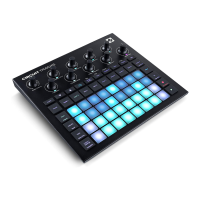94 95
Side Chain View will display either the side chain controls for the Synth tracks or the MIDI tracks (the
external inputs) depending on which track was selected when Shift + FX was pressed. You can use the
J and K buttons
15
to switch between Synth and MIDI track Side Chain Views.
The two lower rows of pads corresponds to the seven Side Chain Presets (Pads 2 to 8 in each row) for
Synth 1 and Synth 2 respectively (or MIDI 1 and MIDI 2); the first pad in each row is ‘the OFF button’ –
this disables side chain processing for the synth (or audio input). Pad 1 is illuminated bright red when
the Side Chain is OFF; press any other pad in the row to enable one of the Side Chain Presets, and
Pad 1 becomes dim and the selected Pad shows bright in the track colour.
Pads 5 to 8 on the top row let you select which Drum track will be the side chain trigger for the
chosen track (selected by pressing a side chain preset for the track).
As with many of Circuit Tracks’ other features, by far the best way of understanding side chain processing
is to experiment and listen. A good starting point is to set a single synth note to have a Gate value of 16
so that it sounds continuously, and make Drum 1 play a few kick drum beats. As you select different Side
Chain Presets, you’ll hear the different ways in which the continuous synth note is “interrupted” by the
drum. The same Side Chain Preset may have a markedly different effect when used with different synth
patches, so it is worth experimenting with various synth sounds as well. Also note that the effect will be
more or less interesting depending on the relative timings of the synth patterns and Drum 1.
Side Chain ducking will continue even when the level of the source track is reduced to zero in the
Mixer View. This is a feature which can be used quite creatively! However, if you mute the drum track
selected as the key in Mixer View, side chain triggering is disabled.
The Filter Knob
The entire audio output of Circuit Tracks – the sum of the sounds from all six internal tracks plus the
two external audio inputs – is fed through a traditional DJ-style filter section. The control for this is
the large Master Filter knob
2
. The Filter knob is one of the key performance controls and can be
used to radically change the overall sound.
The Filter encompasses both low-pass and high-pass types. A high-pass filter removes low frequencies (bass)
from the output and a low-pass filter removes high frequencies (treble). Circuit Tracks’ Master Filter knob
controls a low-pass filter when you turn it anticlockwise from the centre position and a high-pass filter when you
turn it clockwise from the centre position. Note that the control has a detent in the centre – in this position, no
filtering takes place and the LED below the knob is dimly lit white. As you turn the knob clockwise, you’ll hear
the drums and lower notes disappear leaving you with a much thinner sound; in the opposite direction, the
high notes disappear first, leaving you with a muffled sound. The LED changes to pale blue when either filter
type is active, with the brightness increasing as the control is turned.

